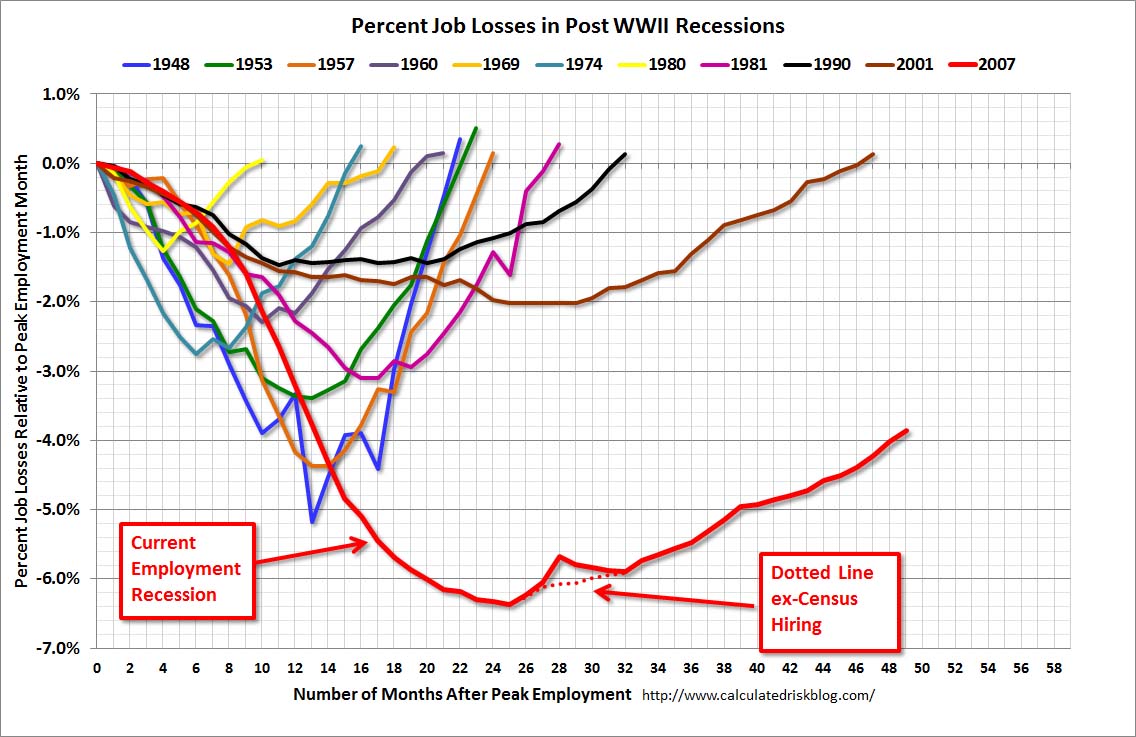Courtesy of Doug Short.
Here is the lead paragraph from the Employment Situation Summary released this morning by the Bureau of Labor Statistics:
Nonfarm payroll employment rose by 227,000 in February, and the unemployment rate was unchanged at 8.3 percent, the U.S. Bureau of Labor Statistics reported today. Employment rose in professional and businesses services, health care and social assistance, leisure and hospitality, manufacturing, and mining.
Today’s numbers numbers are slightly better than the briefing.com consensus, which was for 220K new nonfarm jobs but below Briefing.com’s own estimate of 275K nonfarm jobs.
The unemployment peak for the current cycle was 10.0% in October 2009. The chart here shows the pattern of unemployment, recessions and both the nominal and real (inflation-adjusted) price of the S&P Composite since 1948.
Unemployment is usually a lagging indicator that moves inversely with equity prices (top chart). Note the increasing peaks in unemployment in 1971, 1975 and 1982. The inverse pattern becomes clearer when viewed against real (inflation-adjusted) S&P Composite, with its successively lower bear market bottoms. The mirror relationship seems to be repeating itself with the current and previous bear markets.
The second chart shows the unemployment rate for the civilian population unemployed 27 weeks and over. The January number is 3.6% — unchanged from last month. This measure gives an alternative perspective on the relative severity of economic conditions. As we readily see, this metric remains significantly higher than the peak in 1983, which came six months after the broader measure topped out at 10.8%.
The next chart is an overlay of the unemployment rate and the employment-population ratio. This is the ratio of the number of employed people to the total civilian population age 16 and over.
The inverse correlation between the two series is obvious. We can also see the accelerating growth of women in the workforce and two-income households in the early 1980’s. Following the end of the last recession, the employment population has three times bounced at 58.2% — a level that harkens back to the 58.1% ratio of March 1953, when Eisenhower was president of a country of one-income households, the Korean War was still underway, and rumors were circulating that soft drinks would soon be sold in cans. The latest ratio is 0.4% off the interim low and remains in the center of the oscillating ratio of the late 1970s and early 1980s.
The employment-population ratio will be interesting to watch going forward. The first wave of Boomers will be a downward force on this ratio. The oldest of them were eligible for early retirement when the Great Recession began, and the Boomer transition to the retirement will accelerate over the next several years.
What is the average length of unemployment? As the next chart illustrates, we are perhaps seeing a paradigm shift — the result of global outsourcing and efficiencies of technology. The post-recession duration of unemployment has continued to rise, with the latest 40.0 weeks still not far below the 40.9 week all-time high of last November. It had approached a level nearly double the peak in 1983 following the 1981-82 recession.
The last chart is one of my favorites from Bill McBride at Calculated Risk. It shows the job losses from the peak employment month since World War II. Note the addition of the dotted-line alternative for the current cycle, which shows unemployment excluding the temporary census hiring.
The start date of 1948 was determined by the earliest monthly unemployment figures collected by the Bureau of Labor Statistics. The best source for the historic data is the Federal Reserve Bank of St. Louis.
Here is a link to a Google source for customizable charts on US unemployment data (not seasonally adjusted) since 1990. You can compare unemployment at the national, state, and county level.








